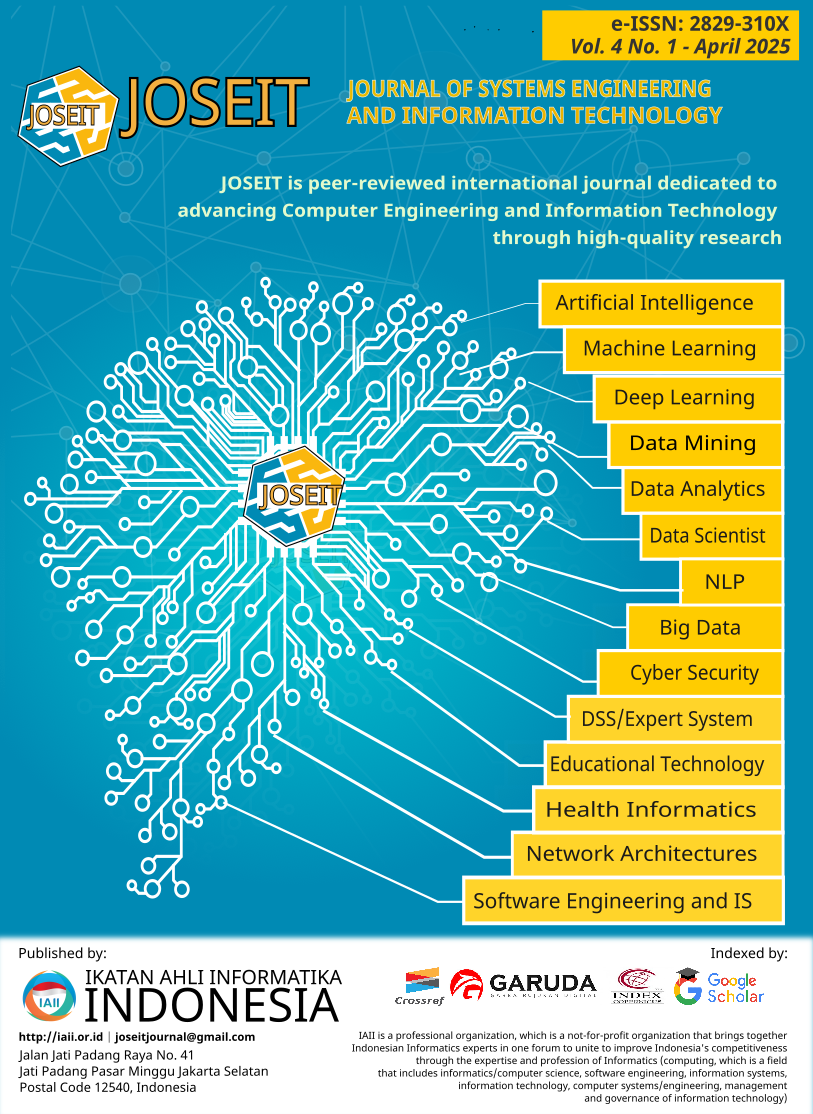Multi-Class CNN Models for Banana Ripeness Classification
Abstract
This study develops and evaluates Convolutional Neural Network (CNN) models for classifying banana maturity stages using images, thereby addressing a significant challenge in the banana supply chain. The banana industry represents a major agricultural sector worldwide, with Brazil exporting 56.2 thousand tons in 2023. Accurate maturity classification is essential for optimizing harvest timing, reducing postharvest losses, and extending shelf life. We utilized a public Brazilian dataset of 1,000 images of Prata Catarina banana categorized into eight ripening stages based on peel coloration standards established by the Brazilian Program for Horticulture Modernization. The images were preprocessed to a standardized 200 × 200-pixel resolution, and we evaluated the effectiveness of the data augmentation techniques, including horizontal flip, vertical flip, rotation, and zoom. Our CNN architecture consisted of five convolutional blocks with a dropout layer prior to flattening. We conducted six experiments to compare three classification scenarios (eight, five, and two ripeness classes) with and without data augmentation. Our findings demonstrate that CNN models can effectively classify banana ripeness, with performance improving significantly as classification granularity decreases. The best-performing model achieved 89.5% accuracy, 87.2% precision, and 89.6% recall when classifying bananas into two categories.
Downloads
References
M. P. S. Jiménez and I. Tobes, “Upcycling the Banana Industry in Ecuador: A Methodology to Estimate Biowaste and Catalogue of Bioproducts,” Int J Adv Sci Eng Inf Technol, vol. 13, no. 5, 2023, doi: 10.18517/ijaseit.13.5.19031.
C. L. Damasceno et al., “Postharvest biocontrol of anthracnose in bananas by endophytic and soil rhizosphere bacteria associated with sisal (Agave sisalana) in Brazil,” Biological Control, vol. 137, 2019, doi: 10.1016/j.biocontrol.2019.104016.
D. H. Reinhardt, J. A. Dos Santos-Serejo, and J. Da, “Panorama of the banana industry in latin america and the caribbean islands, with a special focus on brazil,” Acta Hortic, vol. 986, 2013, doi: 10.17660/actahortic.2013.986.1.
G. M. Napoleão, P. R. R. Jesus, and S. Leonel, “Cultivar diversification of banana production in Brazil,” Agronomy Science and Biotechnology, vol. 7, 2021, doi: 10.33158/asb.r127.v7.2021.
É. I. A. de Souza, H. dos S. Pereira, and A. E. D. de Sousa, “Evaluation of losses in bananas produced in the Rio Preto da Eva, Amazonas, Brazil,” Revista em Agronegocio e Meio Ambiente, vol. 14, no. 3, 2021, doi: 10.17765/2176-9168.2021V14N3E8269.
D. Surya Prabha and J. Satheesh Kumar, “Assessment of banana fruit maturity by image processing technique,” J Food Sci Technol, vol. 52, no. 3, 2015, doi: 10.1007/s13197-013-1188-3.
M. Amin, M. Hossain, M. Rahim, and M. Uddin, “Determination of optimum maturity stage of banana,” Bangladesh Journal of Agricultural Research, vol. 40, no. 2, 2015, doi: 10.3329/bjar.v40i2.24557.
L. Ma et al., “Prediction of banana maturity based on the sweetness and color values of different segments during ripening,” Curr Res Food Sci, vol. 5, 2022, doi: 10.1016/j.crfs.2022.08.024.
J. Enríquez and M. Macas, “Artificial Intelligence-Based Banana Ripeness Detection,” in Communications in Computer and Information Science, 2023. doi: 10.1007/978-3-031-24985-3_15.
E. Almeyda and W. Ipanaqué, “RECENT DEVELOPMENTS OF ARTIFICIAL INTELLIGENCE FOR BANANA: APPLICATION AREAS, LEARNING ALGORITHMS, AND FUTURE CHALLENGES,” Engenharia Agricola, vol. 42, no. SpecialIssue, 2022, doi: 10.1590/1809-4430-Eng.Agric.v42nepe20210144/2022.
I. A. Sabilla, C. S. Wahyuni, C. Fatichah, and D. Herumurti, “Determining banana types and ripeness from image using machine learning methods,” in Proceeding - 2019 International Conference of Artificial Intelligence and Information Technology, ICAIIT 2019, 2019. doi: 10.1109/ICAIIT.2019.8834490.
F. M. A. Mazen and A. A. Nashat, “Ripeness Classification of Bananas Using an Artificial Neural Network,” Arab J Sci Eng, vol. 44, no. 8, 2019, doi: 10.1007/s13369-018-03695-5.
G. Morais et al., “Classification Criteria for Cavendish Bananas and a Framework to Indicate the Correct Destination,” in The 1st International Online Conference on Agriculture—Advances in Agricultural Science and Technology, Basel Switzerland: MDPI, Jul. 2022, p. 65. doi: 10.3390/IOCAG2022-12313.
C. Shorten and T. M. Khoshgoftaar, “A survey on Image Data Augmentation for Deep Learning,” J Big Data, vol. 6, no. 1, 2019, doi: 10.1186/s40537-019-0197-0.
C. Shorten, T. M. Khoshgoftaar, and B. Furht, “Text Data Augmentation for Deep Learning,” J Big Data, vol. 8, no. 1, 2021, doi: 10.1186/s40537-021-00492-0.
R. Amalia and F. Panjaitan, “Mask Detection Using Convolutional Neural Network Algorithm,” Jurnal RESTI (Rekayasa Sistem dan Teknologi Informasi), vol. 6, no. 4, pp. 639–647, 2022, doi: 10.29207/resti.v6i4.4276.
O. D. Annesa, C. Kartiko, and A. Prasetiadi, “Identification of Reptile Species Using Convolutional Neural Networks (CNN),” Jurnal RESTI (Rekayasa Sistem dan Teknologi Informasi), vol. 4, no. 5, pp. 899–906, 2020, doi: 10.29207/resti.v4i5.2282.
V. Chang, R. O. Eniola, L. Golightly, and Q. A. Xu, “An Exploration into Human–Computer Interaction: Hand Gesture Recognition Management in a Challenging Environment,” SN Comput Sci, vol. 4, no. 5, 2023, doi: 10.1007/s42979-023-01751-y.
J. Hung et al., “Keras R-CNN: Library for cell detection in biological images using deep neural networks,” BMC Bioinformatics, vol. 21, no. 1, 2020, doi: 10.1186/s12859-020-03635-x.
A. Muhandisin and Y. Azhar, “Malaria Blood Cell Image Classification using Transfer Learning with Fine-Tune ResNet50 and Data Augmentation,” Jurnal RESTI (Rekayasa Sistem dan Teknologi Informasi), vol. 6, no. 5, pp. 891–897, 2022, doi: 10.29207/resti.v6i5.4322.
Copyright (c) 2025 Journal of Systems Engineering and Information Technology (JOSEIT)

This work is licensed under a Creative Commons Attribution 4.0 International License.
Authors who publish with this journal agree to the following terms:
- Authors retain copyright and grant the journal right of first publication with the work simultaneously licensed under Creative Commons Attribution 4.0 International License that allows others to share the work with an acknowledgment of the work's authorship and initial publication in this journal.
- Authors are able to enter into separate, additional contractual arrangements for the non-exclusive distribution of the journal's published version of the work (e.g., post it to an institutional repository or publish it in a book), with an acknowledgment of its initial publication in this journal.
- Authors are permitted and encouraged to post their work online (e.g., in institutional repositories or on their website) prior to and during the submission process, as it can lead to productive exchanges, as well as earlier and greater citation of published work (Refer to The Effect of Open Access).











.png)




